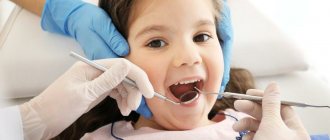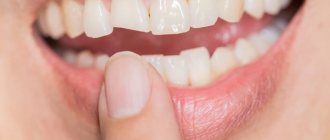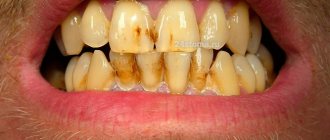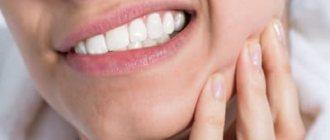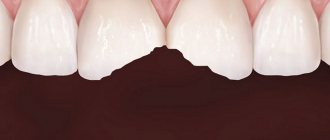- Causes
- Diagnostics
- Symptoms
- Treatment
- Prevention
If a patient complains that his teeth have increased sensitivity, the doctor usually diagnoses “enamel hyperesthesia.” This disease means high sensitivity of teeth to temperature, chemical and mechanical stimuli.
This phenomenon is quite common; hyperesthesia of hard dental tissues is diagnosed in almost every second visitor.
Tooth sensitivity can be either an independent disease or a concomitant symptom of caries, enamel erosion, periodontal disease, increased abrasion of tooth enamel or wedge-shaped defect. Most often, severe sensitivity annoys patients with non-carious lesions of dental tissues, in which the enamel layer becomes thinner and dentin is exposed.
Sensitivity of tooth enamel is also observed with carious lesions. In this case, there may be no external manifestations of caries, but the painful reaction of the tooth to thermal or chemical irritants should alert both the patient and the doctor, because perhaps this is one of the first signs of incipient caries.
Increased sensitivity of the neck of the tooth can also be a symptom of periodontal disease, in which the neck of the teeth becomes exposed and reacts with acute pain to hot or cold food.
Typically, patients complain that the tooth feels cold and hot, and the nature of the pain can be very diverse - from acute intense but quickly passing pain in a single tooth to long-term dull pain in the area of several at once. Most often, patients note increased sensitivity to hot, cold, sweet and sour. At the site of dislocation, sensitivity of the teeth is usually noted near the gums, at the base of the tooth.
Causes of hyperesthesia
Dental hypersensitivity is caused by many factors and may indicate problems with the teeth and periodontal tissues. Hypersensitivity is one of the most common diseases in dental practice and, according to WHO, is increasing every year.
The mechanisms of the occurrence of pain syndrome due to irritating factors stimulate increased interest among both researchers and practicing dentists, prosthetists, and hygienists. This attention is explained by the fact that pain is a key symptom of most dental diseases. However, the increased susceptibility of hard tissues cannot be justified by the known pathways of nerve signal transmission. This fact prompted a series of studies to be carried out, which resulted in several theories of the development of hyperesthesia:
- odontoblastic;
- receptor;
- threshold;
- hydrodynamic.
Sufficient evidence has been collected in favor of the hydrodynamic theory. It is supported by most dental clinicians. The dentinal tubule, according to theory, is considered as a capillary tube containing fluid inside.
Exposure to air, high temperatures, etc. it shifts, the pressure in the dentin changes. This leads to increased activity of nerve endings. Penetration of irritants into the tubules is possible when dentin, the main hard tissue of the tooth, is exposed. It is exposed not only against the background of carious lesions and diseases of periodontal tissues, but also as a result of non-carious defects: hypoplasia (underdevelopment of teeth), enamel erosion, etc.
How exactly does pain occur?
To understand the mechanism of pain when eating cold or hot food, it is enough to remember the structure of the tooth. We call the topmost, visible layer enamel. This is the most durable tissue of the human body, which reliably protects the more sensitive tooth tissues from any irritants, including thermal ones.
But if you neglect your health or due to chronic diseases, the enamel becomes thinner, exposing dentin. It, in turn, is permeated through and through with hollow tubules, which begin at the pulp itself. And without a barrier in the form of durable enamel, irritants: cold air, cold and hot drinks easily pass through the tubules of the dentin and begin to directly affect the nerve endings. The patient experiences a sharp attack of pain.
Hypersensitivity after tooth filling and preparation for dentures
Most often in dental practice, increased sensitivity is observed after filling. Patients come to the clinic with complaints of sensitivity, especially to cold, without precise localization of pain. Upon visual examination, sensitivity in the basal part is not detected. There is no evidence of open pulp or caries on the x-ray.
The causal unit, however, can be identified. To do this, use ice, which, wrapped in a paper napkin, is applied to the cheek area or to the surface of the tongue. An area with a violation of integrity in hard tissues is a source of irritation, so severe pain occurs in the tooth. Removing all filling material will allow you to detect the break.
The reason for increased susceptibility, often to cold or too hot food, may be the appearance of microgaps between the filling and the hard tissues of the tooth due to compression of the composite material. The gap formed in the cavity near the root canals opens up space for the movement of dentinal fluid, thereby causing a response from the nerve endings of the pulp.
The area of contact of the material with the walls of the internal space of the tooth can also contribute to the formation of hypersensitivity after filling. Since filling composites have a high elasticity index, they cause stress in the contact layer “filling - hard dental tissue”. The tension in the tooth tissues is greater in cases where the surface of the restoration in contact with the walls is extensive.
After preparation (grinding) of a tooth for prosthetic structures and microprostheses, normal sensitivity is observed, which is characterized by mild pain. If there is no inflammatory process in the pulp, the pain is considered causative and disappears a few minutes after the drill stops working. If hypersensitivity persists for a long time (2 or more days after the procedure), treatment of pulpitis is required.
Provoking factors for the development of dental hypersensitivity
Most often, increased sensitivity is a consequence of a violation of the integrity of the enamel or destruction of the hard tissues of the teeth, which increases the risk of irritation of the endings of the nerve fibers.
The key provocateurs are caries lesions, exposure of the necks and roots of the teeth. Hyperesthesia is diagnosed as a sign of a number of non-carious lesions - enamel defects, progressive loss of enamel and dentin with a decrease in crown height, local destruction, acid necrosis, traumatic injuries, periodontitis with an aggressive course, metabolic disorders of the body, endocrine diseases, mental disorders.
The disease can also occur when consuming large quantities of acidic foods and drinks. Under the influence of acids, the enamel softens and loosens, and erosion appears on its surface.
Increased sensitivity of teeth can be observed after removal of hard dental tissues in order to create a prosthetic space for metal-ceramic structures.
One of the provoking factors is bleaching, during which aggressive chemical bleaching agents are used.
The most common provoking factors also include:
- pulpitis, other dental diseases or pathological conditions that cause destruction of tooth enamel;
- disruptions in the body caused by uncontrolled use of hormonal drugs;
- stress;
- chronic gastrointestinal diseases;
- malocclusion;
- incorrectly selected hygiene products (hard bristled brushes, highly abrasive paste);
- bad habits.
Diagnostics
When diagnosing dentin hypersensitivity, it should be borne in mind that it is often a symptom of a disease. Therefore, when a patient approaches, the dentist begins treatment with a survey, during which he receives answers to the following questions:
- duration and nature of the pain syndrome;
- number of units with dentin sensitivity;
- localization of increased susceptibility;
- characteristics of stimuli that cause pain.
After the examination, the patient is required to undergo probing of sensitive areas and other diagnostic tests (thermal, electrical, osmotic, evaporative), as well as percussion (tapping on individual areas of the tooth). At the same time, they find out whether the element is sensitive when biting, identify microcracks in the enamel, damage inside and around the filling, malocclusion, and signs of bruxism.
In addition, diagnostics are carried out using hardware methods and “hidden” carious lesions and periapical changes are identified if they are present.
Much attention is paid to determining the level of pain and the degree of tooth sensitivity:
- no pain;
- mild discomfort;
- medium intensity;
- severe pain or unbearable.
The patient's pain reaction may occur to a greater extent to thermal stimuli (cold, heat), tactile (tactile), evaporative (air), electrical or osmotic (solutions of weak acids).
Dentists note that the reaction most often occurs to cold, brushing teeth, heat and sweets.
The more dentin is exposed due to dental diseases and other factors contributing to enamel loss, the higher the degree of hyperesthesia. This is explained by the fact that in completely exposed dentin there are more dilated tubules with open holes.
What complications may arise?
The good news is that the tooth’s reaction to hot food is only the first stage of hyperesthesia. And if you contact your dentist in a timely manner, in just a few weeks you will forget about the problem.
If you ignore the slight discomfort from hot tea or coffee, very soon the tooth will begin to react to sweet, salty and spicy foods. In this case, simply unpleasant sensations will be replaced by severe pain, which will no longer recede in 2-3 seconds, but will begin to disappear only after rinsing the mouth, then after taking painkillers. This is the second stage of hyperesthesia.
There is a third one. Now the enamel is so thin that any touch to the tooth is unbearable. Eating, walking in cool weather, drinking tea, brushing your teeth - all this is accompanied by acute, piercing pain. And the worst thing is that it may no longer be possible to restore the native enamel on the teeth at this stage, despite the extensive arsenal of modern dentistry methods.
15% discount on emergency care for acute pain!
Moscow
Initial measures to eliminate signs of hyperesthesia
To eliminate unpleasant sensations, the doctor primarily gives the patient the following recommendations:
- exclude predisposing factors;
- do not consume food acids, that is, refuse those products that contain them;
- Carry out hygienic teeth cleaning long before or after meals;
- Reduce the time you spend brushing your mouth to one minute and use a soft-bristle brush.
The patient's teeth are treated with desensitizers. They reduce the sensitivity of teeth of various etiologies by sealing the dentinal tubules. The use of special toothpastes is prescribed.
When the root and neck of a tooth are exposed, mucogingival surgery (vestibuloplasty, etc.) is used to correct gum recession. During surgery, the soft structures of the oral cavity are moved to those areas that require restoration.
For pulpitis, the doctor resorts to pulpotomy. During a dental operation, the pulp is partially amputated using a vital method. At the same time, that part of it that is located in the root canal remains viable.
If sensitivity to irritants persists, additional diagnostics are carried out to exclude chronic pain syndrome, and a more effective treatment plan is drawn up.
Consultation with a dentist
When the first signs of sensitivity appear, you should immediately make an appointment with the dentist. The doctor will determine the cause, prescribe appropriate therapy and advise on oral care issues. The main thing is not to let the disease progress. Timely treated caries will not lead to complications. Detailed information can be found here: treatment of initial caries.
In addition to therapy, the dentist prescribes medications and prescribes procedures. Oral hygiene and high-quality balanced nutrition are of great importance. The first-priority procedure that is performed on a patient with a high degree of sensitivity of units is the removal of solid deposits. Ultrasonic cleaning has performed well in this regard. It also strengthens the soft gum tissue.
Using a special paste, the teeth are covered with a thin film, which protects them from the external aggressive environment. Today, the device is actively used for gum massage. This is an irrigation device where rubber bristles are used instead of classic bristles. It also washes away food residues with a stream of water. Vitamin complexes are prescribed to strengthen the immune system, which accelerates the healing of inflamed areas and strengthens the tissues of the oral cavity. Follow the link Dental treatment in St. Petersburg and sign up at the ARTE-S clinic. The sooner the problem is identified, the easier and cheaper the therapy will be!
Treatment methods for tooth sensitivity
For treatment, medications, combination therapy, complex therapy and physical methods are used.
Algorithm of the doctor’s actions in the treatment of dentin sensitivity:
- decreased excitability of the neuroreceptor apparatus of the dental pulp;
- decreased dentin permeability;
- blocking the entrances and obstructing the lumens of the dentinal tubules;
- mineralization of hard tooth tissue.
Based on the clinical picture, complex therapy may be prescribed, including obturation of the lumens of the dentinal tubules and electrophoresis with sodium fluoride solutions. The entrances of the tubules are closed with resin-containing or salt-containing desensitizers.
Laser therapy, a procedure for reducing pores using remineralizing gels, restoring gums in case of receding gums, filling teeth in places where the protective layer is thinning, and coating the enamel with fluoride varnish can also be used.
At home, the patient is recommended to use pastes containing strontium chloride, potassium nitrate, and sodium citrate for hygienic care.
Medication treatment at home
Dentists consider the use of special gels, rinses, and toothpastes with or without very mild abrasives to be effective treatment at home.
When treating hypersensitivity, potassium nitrate is recognized as the most effective remedy. The therapeutic effect when using hygiene products that contain it occurs as a result of the penetration of potassium ions into the dentinal tubules, where they accumulate, surround the nerves in the pulp areas of the tubules and block their activity, thereby reducing the excitability of the nerve endings.
To achieve the effect, it is recommended to maintain a high concentration of potassium nitrate on the surface of the causative tooth or group of teeth. Potassium nitrate can be used as a solution, gel, paste, or other oral hygiene products.
When using toothpastes containing potassium nitrate or chloride and sodium monofluorophosphate, as when using potassium nitrate alone, hypersensitivity to tactile stimuli and cold air is reduced.
If, after two weeks of daily use in the morning and evening, the therapeutic effect of brushing teeth and applying products containing the substance is not observed, then the patient is recommended to wear mouth guards. They are filled with the same compositions and worn at night. Symptoms of hyperesthesia disappear after two weeks.
Also, positive dynamics in home therapy for hypersensitivity are shown by hygiene products that contain fluorides, strontium salts (chloride or acetate), calcium glycerophosphate or hydroxyapatite.
Sources used in writing the article:
- “Modern aspects of pain and local anesthesia in dentistry” (2003), Duiseeva G. Sh., Ruzuddinov S. R.
- “Dentistry: a textbook for universities” (2008), ed. N.N. Bazhanova.
- "Occlusion and Clinical Practice" (2008), Jaeger Klinenberg
Please rate this article
Stanislav Mezheritsky
Chief physician, surgeon, orthopedist
The author of the article is Stanislav Mezheritsky, a practicing dentist with 19 years of experience, chief physician and one of the founders of the Matisse Dent clinic. The main focus is orthopedic and surgical dentistry. Author of numerous publications, regular participant in specialized seminars.
Disease prevention
The basis for preventing high sensitivity to external irritants, including hot and cold food, is to visit the dentist at least once every six months. Relief from hyperesthesia is possible only with timely detection of carious cavities, wedge-shaped defects and other problems. To preserve the health of your teeth and the integrity of your enamel, it is recommended to follow your doctor’s prescriptions and follow simple rules of care.
- Teeth brushing is carried out smoothly, without unnecessary pressure, which prevents mechanical damage to the gums and the entry of pathological microorganisms into the wounds.
- In addition, it is advisable to use mouth rinses after each meal, sour and sweet drinks.
- When using dental floss and sticks, it is necessary to prevent injury to the gingival papillae.
- Nutrition is of great importance for dental health. The diet must include foods containing potassium and phosphorus: vegetables, fruits, fish, seafood, flax seeds. It is advisable to exclude sweet and sour foods from the menu. Juices and carbonated drinks are recommended to be consumed through a straw.
- Hot and cold foods should be avoided; tea, coffee, and soups should be cooled to a comfortable temperature that does not affect sensitive receptors.
- Regular oral hygiene is important. For daily use, gel pastes with a low level of abrasiveness are recommended, as well as soft or medium-hard brushes with rounded bristles and an even shape.
Considering the influence of the nervous system on all processes occurring in the body, it is very important to change negative psychological attitudes and learn to think in a positive way. In some situations, it may be necessary to take mild sedatives (Afobazol, Novopassit, Melaxen).



